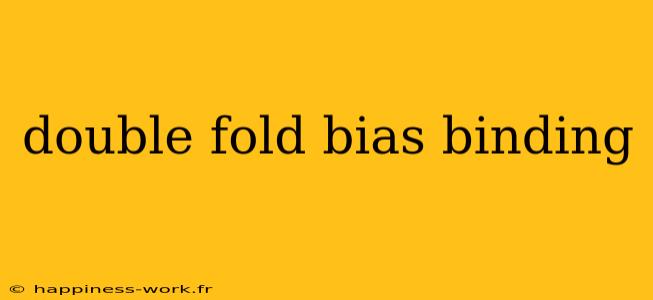Double fold bias binding is a versatile sewing tool that can enhance the look and durability of your projects. From finishing raw edges to creating a decorative touch, understanding how to use this binding can elevate your sewing skills. This article will dive into what double fold bias binding is, how to use it, tips for application, and additional insights that will help you make the most out of this handy sewing accessory.
What is Double Fold Bias Binding?
Double fold bias binding is a strip of fabric that has been cut on the bias (at a 45-degree angle to the grain of the fabric). The strip is folded in half lengthwise and then the two edges are folded inward towards the center crease. This results in a binding that is neatly finished and ready to be sewn onto the edges of your fabric.
Why Use Bias Binding?
Using double fold bias binding has several benefits:
- Versatility: It can be used on curved or straight edges without puckering.
- Durability: Provides a strong finish that can withstand wear and tear.
- Aesthetic Appeal: Comes in various colors and patterns, making it a perfect decorative element for your projects.
How to Use Double Fold Bias Binding
To ensure you’re using double fold bias binding correctly, here are some key steps to follow:
Step 1: Prepare Your Fabric
Before applying bias binding, ensure that the raw edges of your fabric are cut neatly. Press any seams open for a flat surface.
Step 2: Open the Bias Binding
Open one side of the double fold bias binding to expose the crease. Align it with the edge of your fabric, with the raw edges aligned.
Step 3: Pin and Sew
Pin the bias binding in place, and sew along the edge, approximately 1/4 inch from the edge. This will secure the binding to your fabric.
Step 4: Fold and Press
Once sewn, fold the bias binding over the raw edge so that it encases it completely. Press it down for a neat finish.
Step 5: Final Stitch
To finish, sew the bias binding down on the other side, either by hand or with a machine. This will ensure that the binding stays in place.
Frequently Asked Questions
Here are some common questions and answers about double fold bias binding:
Q: Can I make my own bias binding? A: Yes, you can cut strips of fabric on the bias and fold them to create your own binding. It’s a great way to coordinate colors and patterns with your project.
Q: How do I determine how much bias binding I need? A: As a general rule, measure the length of the edges you want to bind and add a little extra (around 10%) for seams and adjustments.
Q: What types of projects can I use double fold bias binding for? A: Double fold bias binding is great for finishing edges on quilts, bags, clothing, and home decor items like table runners and placemats.
Tips for Success
-
Choose the Right Fabric: For best results, use cotton or cotton-blend fabric for your binding, as they tend to hold their shape well.
-
Use a Bias Binding Tool: Consider investing in a bias binding maker to speed up the folding process. This tool allows for consistent folds and a professional look.
-
Practice on Scraps: If you’re new to using bias binding, practice on scrap pieces before tackling your main project. This will help you get comfortable with the technique.
-
Experiment with Patterns: Don’t shy away from using patterned bias binding! It can be a fun way to add personality and style to your projects.
Conclusion
Double fold bias binding is an essential tool for any sewing enthusiast looking to refine their craft. By understanding how to effectively use and apply it, you can create beautifully finished projects that not only look professional but also stand the test of time. Whether you are finishing a quilt or adding a pop of color to a bag, mastering double fold bias binding can open up a world of creative possibilities.
For more tips and detailed guides on sewing techniques, visit WikiHow for valuable insights contributed by fellow sewing enthusiasts. Happy sewing!
By adding deeper insights, practical examples, and optimizing for SEO, this article is crafted to be engaging and informative for readers seeking to master the art of double fold bias binding.
